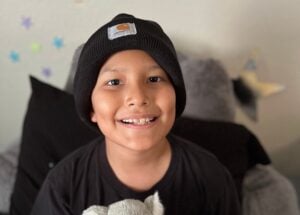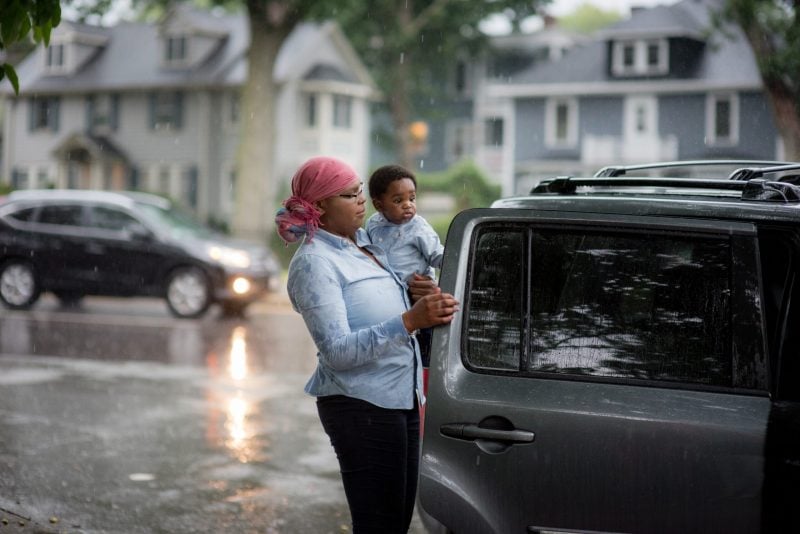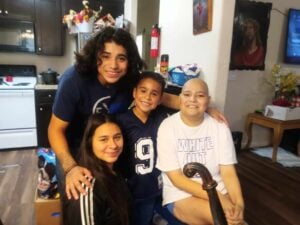
Sights Set on a Strong End to 2023 — Will You Join Us?
Family Reach CEO Carla Tardif reflects on 2023 and calls for community support before the year ends.
When talking about cancer, “patient” and “fighter” often become synonyms. We hear about the brave cancer heroes who win their battle with cancer, and mourn those who lose their fight.
In reality, no two cancer “fights” are the same – it is impossible to lump them all in the same class. A patient can be as strong and resilient as they come, yet still experience challenges that are out of their control.
Social determinants of health (SDOH) are among the challenges weighing against cancer patients. They refer to conditions that influence health outcomes, such as income, housing, food, transportation, race, and ethnicity. They’re largely responsible for health disparities and can, therefore, impact cancer patients’ chances of survival. For example, a patient who earns an hourly wage and doesn’t have health insurance will be at a disadvantage compared to a patient with a salary and benefits who can more easily afford copays and treatment costs.
As a nonprofit that provides financial support to families facing cancer, we know these inequalities well. To further explore how SDOH affect the cancer patients we serve and drive our solutions, we spoke with a few members of our Programs team for their frontline perspectives.
Devin Traxler, MSW, LSW, is one of our rockstar in-house social workers, known in Family Reach lingo as a Resource Navigator. Devin and her fellow Navigators work directly with patients and healthcare professionals to review applications to our services and match families with the best resources for their needs.
Through her conversations with patients and their families, Devin hears firsthand about concerns surrounding multiple social determinants.
“Patients and caregivers always bring up financial stressors that are connected to SDOH, including difficulty paying for housing, food, gas, and parking costs at the hospitals,” she explained. “Ultimately, SDOH create barriers that make it difficult for patients to access treatment, really at any stage of their cancer journey.”

Devin recalled multiple instances where patients described these barriers. For instance, families with flexible employers or help from their community often move to a different city or state to be closer to their treatment center, while others push through the transportation barriers. Our Navigators know that most cancer patients experience an increase in food costs during treatment because of prescribed diets of fresh, healthy foods as well as long days at the hospital that generally only leave time for takeout meals. But for those who live in “food deserts,” there is the extra challenge of even finding high-quality food close to home.
“I’ve spoken to multiple patients who have to delay getting treatment due to challenges like these,” Devin explained. “And I can’t overstate enough how the COVID-19 pandemic has made all of the barriers more intense.”
Elizabeth Herrig, MSW and Director of Programs at Family Reach, shared similar stories about the uneven playing field patients find themselves on the moment they are diagnosed. She highlighted how low-income families have reduced access to specialized or “top-notch” cancer treatment because the best hospitals are too far from home.
“Treatment centers in lower-income communities often lack the robust staffing and resources needed to bridge the gap to many services for families, such as taxi vouchers or support with SNAP benefits applications,” she explained. “On top of that, families living in these communities may also be up against safety issues like housing security, high crime rates, or severe exposure to air pollution.”
Patients cannot control how their socioeconomic status influences the challenges they face during cancer treatment, though they often feel ashamed, embarrassed, or frustrated by needing to ask for help.
“There’s a lot of fear and sadness when people reach out to us, and they say ‘but I did everything right,’” Devin explained. “I want to tell them ‘yes, you did, and you are!’ but unfortunately, no one can plan for cancer and there are systems in place that create barriers to care even if you do everything right.”
Availability and affordability aren’t the same for everyone – and this is only highlighted by a health crisis like cancer. What’s more, the various factors that fall under the SDOH umbrella are all so connected that it’s rare for patients to experience the effects of just one social determinant.

“The intersectionality between the many social determinants is extremely important to note,” Devin said. “For example, discrimination in housing creates a system where certain groups of people – primarily Black Americans and underrepresented groups – can’t buy homes in desirable areas. As a result, they can’t build equity, access areas with higher-income jobs, or live near high-ranking school systems. Their children enter the world already at a lower level of privilege -and the data shows that pediatric cancer patients from low-income neighborhoods relapsing faster than those from wealthier communities.”
Patients carry the weight of these systemic challenges long before they connect with Family Reach. But when the challenges pile up, our patient support services are there to provide immediate relief.
“Our Resource Navigators introduce patients to government programs like SNAP or local food banks, while our financial guidebooks familiarize families with the hidden costs and our financial planners help them map out an appropriate spending plan,” Elizabeth said. “These are all important steps to relieving the burden for families.”
In order to deliver a service that provides the right support to the right patients at the right time, we’re continually refining our data collection for the best representation of who we serve and how well our services are performing.
Andrea Incudine, MPH and Senior Manager of Programs and Evaluation at Family Reach, leads the team dedicated to collecting quality data. These questions guide their process:
To ensure we collect data straight from the source, we ask patients or healthcare providers questions in the financial aid application that give us a complete picture of each family’s situation. From there, our team conducts a financial needs assessment to understand the unique risk level of each family. To do this, we consider SDOH factors like household income alongside the financial disruption caused by their cancer diagnosis.
“Our financial needs assessment has two main goals: prioritize the most vulnerable families and identify the most effective financial resources to their meet their needs,” Andrea explained.
Currently, the evaluation team is analyzing the results of two impact surveys – one completed by families we’ve served and another by healthcare professionals we’ve worked with. The goal is to better understand how certain patients may be disproportionately affected by the financial burden and if our programs are making an impact.
“The story this data will tell is still unraveling, but the results will allow us to develop a complete demographic dashboard of our services,” Andrea said. “We’ll be able to answer telling questions like what services families receive, if there is any service discrepancy based on race or ethnicity, if gaps in patient satisfaction exist, and whether patients and healthcare professionals feel our services are working.”
Along with this data analysis, we listen to patients to best understand their needs and experiences while also connecting with experts in the cancer care community for their valuable perspective. This collaboration is important for intentional, informed, and effective decision-making.
With staff members as talented and passionate as Devin, Elizabeth, Andrea leading the way, we know our financial services are in good hands. And once it reaches patients, our hope is that the support will break down enough barriers to clear the path to healing.

Always walking the fine line between her right and left brain, Stevie brings her creative and strategic thinking to her role as Senior Creative and Brand Manager. Her work amplifies Family Reach’s voice and brings attention to the financial impacts of a cancer diagnosis.

Family Reach CEO Carla Tardif reflects on 2023 and calls for community support before the year ends.

Your holiday giving provides financial relief to families like these who are facing cancer this winter.

Curious what a donation to Family Reach does? Here’s a breakdown of how donations to Family Reach provide financial support to families facing cancer.
Applications will only be reviewed and processed for open funds.
Applications will only be reviewed and processed for open funds.
Applications will only be reviewed and processed for open funds.
Applications will only be reviewed and processed for open funds.
Applications will only be reviewed and processed for open funds.
Join our email list for updates about our events, fundraising campaigns, family stories, partnerships, and the impact of your generous support.